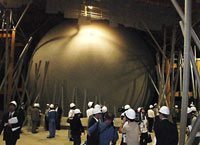|
|
|||||||
|
|
|||||||
|
|||||||
| | Web Japan >> | Trends in Japan >> | Science & Technology >> | Super Competition | |
|
A LEGACY OF SUSTAINABILITY Expo's Structures and Attractions to Be Reused, Recycled (November 25, 2005) Even though the 2005 World Exposition in Aichi, Japan, has shut its gates, many of its exhibits and structures will continue to live on, thanks to extensive recycling efforts in line with the event's goal of environmental sustainability. Expo 2005, which drew more than 22 million visitors in its six-month duration from March 25 to September 25, stressed the theme of "Nature's Wisdom." The sub-theme of "Development for Eco-Communities" was summed up by the phrase "reduce, reuse, recycle," also referred to as "the three Rs." Organizers were determined to ensure that these ideals were adhered to even after the event finished. Up for Auction At the forefront of such efforts are the organizers of the Japan Pavilion, who have been stressing the benefits of recycling on the pavilion's website (titled "Re-use Nippon-kan") and elsewhere. Right from the planning stage, the designers of the Japan Pavilion selected materials that would be easy to recycle and produce a minimal amount of waste after the building was dismantled. Around 20,000 items, including the wood and bamboo used to construct the pavilion, as well as electrical sockets and switches, will be auctioned off after the building is taken apart. The website states that the reuse of materials is the Japan Pavilion's final project and expresses the hope that this idea is realized and remains with the people throughout the country who purchase items used in the pavilion. Finding New Homes Another piece of Expo equipment bound for a new home is the "Dry Mist" sprayer, which kept visitors cool amid the heat of summer by spraying them with a fine mist. A local government plans to acquire and use the machine. Recycling Power In a similar plan, Chubu Electric Power Co. will take possession of a solar power generator used as a power source for fountains and other water displays at the Wonder Circus-Electric Power Pavilion, one of the Expo's most popular attractions. Chubu plans to keep the generator operating. Another crowd pleaser was the Linear Motorcar, which was displayed at the JR Central Pavilion and was a favorite spot for visitors to take photos commemorating their day at the Expo. In the near future it will be used in endurance tests in Nagoya to see how it fares in inclement weather. Efforts are also being made to see if the pipes installed in the site's exterior walls can be recycled, while officials are considering whether the uniforms worn by Expo staff members can be somehow reused in the future. Even the site itself is slated to be reused as a park that will retain a few structures and attractions from the Expo, including Satsuki and Mei's House. Many of the exhibits and structures once belonging to the corporate and foreign pavilions will be presented as gifts to various places throughout Japan. In their new locations and roles, these recycled and reused objects will continue to embody the legacy of Expo 2005 well into the future. Copyright (c) 2005 Web Japan. Edited by Japan Echo Inc. based on domestic Japanese news sources. Articles presented here are offered for reference purposes and do not necessarily represent the policy or views of the Japanese Government. |
|
|
|




